
* About a half-billion years ago, life on Earth evolved into multicellular forms and began a rapid diversification, with large organisms becoming commonplace and, over the next few hundred billion years, expanding onto the land to cover the continents.
Late in the Proterozoic Eon, the breakup of Rodinia continued, with the result of ending the long cycles of ice. One large component, named "Gondwana", remained; it stretched from the South Pole to above the equator. It would give birth to all the southern continents, plus a good part of Asia. Most of the Northern Hemisphere remained ocean, though there were components, most notably Laurentia, that would eventually come together to form North America, Europe, and Siberia.
About 600 million years ago, during the Ediacaran, the period that capped the Proterozoic, the first multicellular organisms appeared. 570 million years ago, from the beginning of the Cambrian Period -- which kicked off the last of the four eons of Earth, the Phanerozoic Eon -- the diversification of multicellular organisms went into high gear.
Multicellular organization seems like it was a big step forward. A multicellular organism such as ourselves has the trick of starting out with a single cell whose genetic "program" knows how to direct the organization of all successor cells, with cells taking on different forms. Each cell runs the same program, but its operation is modified by the cell's environment, that environment including the collective of the cells of the organism and the chemical signals they send to each. In seeming magic, the cells "talk to each other" to cooperatively shape the whole: a place for everything, and everything in its place. It appears that organisms were beginning to acquire the trick of multicellular organization as far back as 1.2 billion years ago. It is an elaborate trick, and we're still learning about how it works.
On consideration, however, was multicellular organization such an abrupt step forward? In some ways, multicellular organization seems like a straightforward evolutionary path. Single-celled organisms often form colonies; after all, if they reproduce by fission, there's no absolute reason for the daughter organisms to separate, and they can easily form strands or mats or other forms. One organism that could be seen as a sort of "living fossil" is the "volvox", a colony of protist algae that takes on a neat spherical form. Genetic analysis shows that its genome is very similar to that of single-celled relatives, the changes involved in acquiring multicellular organization being minor.
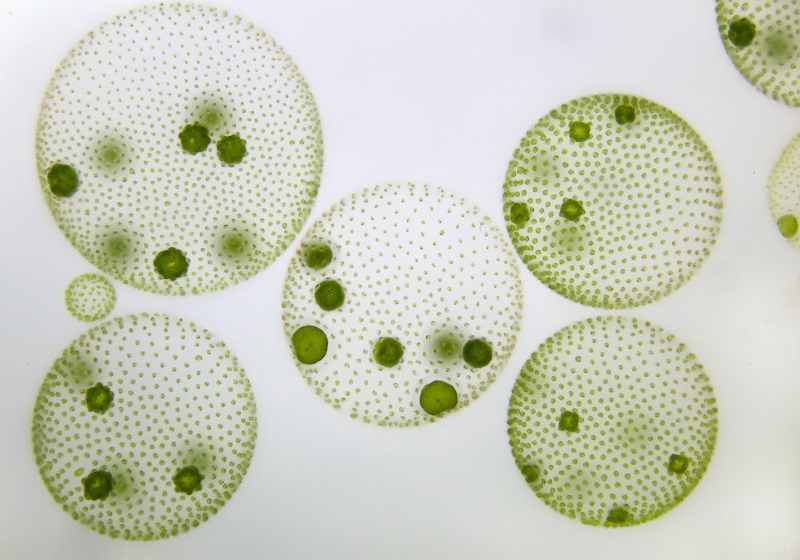
Obviously, it was not such a big step to develop more sophisticated organizations, with the sophistication gradually building on itself. There are modern organisms that suggest intermediates of multicellular organisms, partial steps beyond mere undifferentiated colonial assemblies. One of the best-known examples is the "slime mold" -- a form of amoeba that, while capable of living individually and reproducing through fission like any good amoeba, will on occasions congregate, under the influence of a chemical signal the amoebas discharge, to form a mobile, sluglike multicellular mass. This mass will eventually then form a stalk up into the air that will burst into spores, which are scattered to form up new amoebas, starting the cycle all over again. All the individual amoebas in the slime mold are the same, but they have the biochemical "smarts" to do a pretty convincing act as a multicellular organism when the times require -- some of the slugs becoming fibrous to support the stalk, others acting to ingest and destroy pathogens, sacrificing themselves to support the propagation of the gene line.
Such examples from nature suggest that multicellular organization emerged in phases and isn't a wild improbability. After all, different organisms can form complicated ecologies with webs of neatly interlocked relationships; if the cells of a multicellular organism are regarded as distinct, if not exactly, individual organisms, then their collaboration as a multicellular organism, a "survival machine", is just an "ecology" of interacting organisms written at the cellular level.
It is also easy to exaggerate the complexity of a multicellular organism, because we have a human tendency to think its organization reflects some elaborate blueprint or specification. That is thinking in terms of human machines and misleading. The genome of an organism is not a "blueprint"; it's more like a recipe, a set of rules, and the rules can actually be very simple.
Consider a termite mound, which might be considered as a manifestation of a "superorganism". Such a mound can be very elaborate, with a network of tunnels and chambers. However, termites can't read a blueprint, or read anything else for that matter; the individual termites have no concept of the overall structure they are trying to build, and they end up building the mound using sets of simple "local rules" that govern their behavior. Similarly, the ecology of cells that make up a multicellular organism necessarily work on the basis of "local rules" -- there is no central controller to direct the construction of the organism, the construction instead being directed, in a bottom-up fashion, by the emerging collective itself. Organisms are not "built"; they grow.
* In any case, the most famous late-Precambrian fossil bed is in the Ediacara Hills of South Australia, which gave their name to the Ediacaran period. The classification of the Ediacaran fossils is to no surprise controversial. Taxonomists have enough trouble trying to organize organisms that they can get their hands on, and it's far more troublesome to figure it out when all that they have is a shadow in stone. An insubstantial creature like a jellyfish doesn't even leave much of a shadow, so it's very difficult to figure out how to pigeonhole the creatures of the Precambrian. Is a particular organism a precursor of some modern form, or does it represent an early "experiment" that went to a dead end?
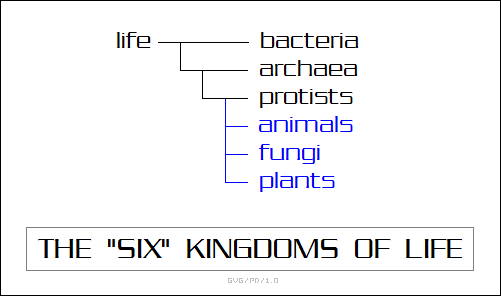
It's difficult to know one way or another, but it does seem that by the late Precambrian what we would call enough to produce early members of the three most familiar kingdoms of life:
There's a common inclination to see fungi as plants, since like plants they are immobile, but they're really no more plants than we are. Certainly those who have ever had a fungal infection on their toes might wonder what kind of plant it is that eats away living flesh. There are, however, halfway cases:
The fungi are not particularly well represented in the fossil record; microfossils are common, but not very informative, and few large fungal bodies, such as mushrooms, have ever been discovered as fossils. The plants and particularly the animals have a more detailed fossil record, and so draw more interest.
BACK_TO_TOP* The different groupings of animals are elaborate and it's worthwhile to look over their organization before going further. The overall kingdom of animals consists of three different groups of phyla or "superphyla".
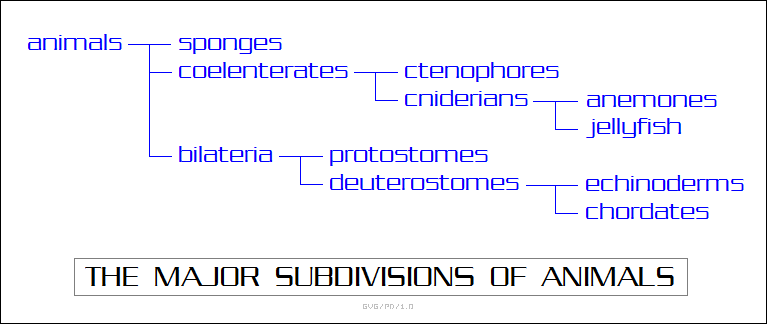
The first, the sponges, can be seen as suggestive of a further intermediate, beyond slime molds, towards multicellular organization. Sponges look like colonial protists, and in fact some species can be run through a strainer to break them down into individual cells -- which will reassemble themselves into a sponge. Do this to two sponges, and the cells from the two will reassemble their original collectives without confusion. They do have a set of specialized cell types, but all the cells are "totipotent", meaning that any one cell can grow all the others and create a new sponge. They can be seen as a rough model of what "primitive" multicellular organisms looked like -- "primitive" in the sense of being "primal", ancient and ancestral in form, if not necessarily "crude" in some sense. Very small fossils of what look like sponges dated as 600 million years old have been found in China, suggesting sponges were around in the Precambrian.
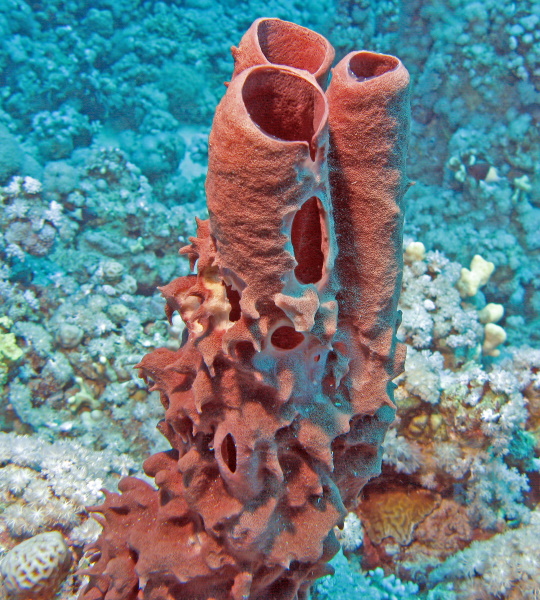
The second, the "coelenterates", includes two major phyla, the "cnidarians" and the "ctenophores" -- incidentally, "cnidarian" is more or less pronounced as "nigh-derry-ann" and "ctenophore" is more or less pronounced "ten-oh-four". The cnidarians include jellyfish, hydras, anemones, and corals; anemones and corals can be thought of as jellyfish turned upside down, with corals more or less being colonial anemones. The cnidarians are all characterized by their neatly arranged stinging cells, known as "nematocysts" or "cnidocytes", an adaptation unique to their group. Fossils have been discovered of creatures not so unlike the noxious modern medusa, the baglike creature that floats, trailing a tangle of deadly venomous tendrils.
The ctenophores or "comb jellies" were once thought to be part of the jellyfish family, but they lack the cnidocytes, and in fact they are so different at a detail level from ordinary jellyfish that some classify them as a distinct superphylum. Recent studies have shown that while ctenophores have a nervous system, its underlying genetic and structural basis is so different from that of cniderians and most other animals that is it suspected they evolved a nervous system independently of other animals. Early cniderians also had hard body parts, including protective plates; it is an interesting little question as to why cniderians with protection died out.
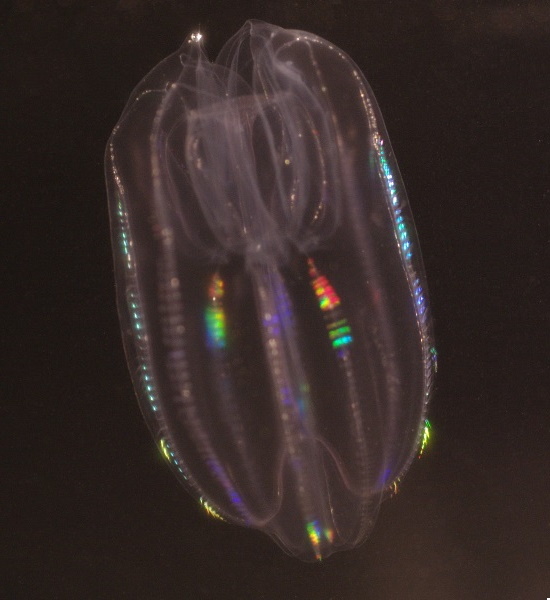
The third, the "bilateria", are animals with bilateral symmetry. (Sponges don't have much symmetry; cnidarians and ctenophores have radial symmetry, just as does a plate.) The bilateria include everything from "primitive" worms to, well, us. The late Precambrian bilateria were generally simple creatures, not so different from the modern "planarian" flatworm, a popular staple of high-school biology classes, where it is often cut in half and otherwise treated sadistically to observe its remarkable ability to regenerate.
Incidentally, calling the planarian "simple" is, once again, misleading. To be sure, its internal organization is simple compared to animals such as humans, but it features what amounted to a remarkable "innovation" in the ancient creatures that it resembles: a brain. Sponges don't have a real nervous system, though they can respond somewhat sluggishly to stimuli. Jellyfish and corals have a nervous system, but it's disjointed -- one part of the organism will react to a stimulus, but the unaffected parts won't. Having a nervous system that links up into a central "node", the brain, gives an organism the ability to react to events in a much more decisive fashion.
* The bilaterians are subdivided into two great subclades, the "protostomes" and "deuterostomes", depending on their embryonic development. In early development, the cells of the bilateran embryo grow into a sphere, the "blastula", which then becomes intended to become a "gastrula". The indent is called a "blastopore", and its further development defines the core difference between the two clades:
That may seem like a picky sort of distinction, all the more so because in practice there are variations on the two themes, but it is a fundamental one, establishing the great family divide in the bilaterans.
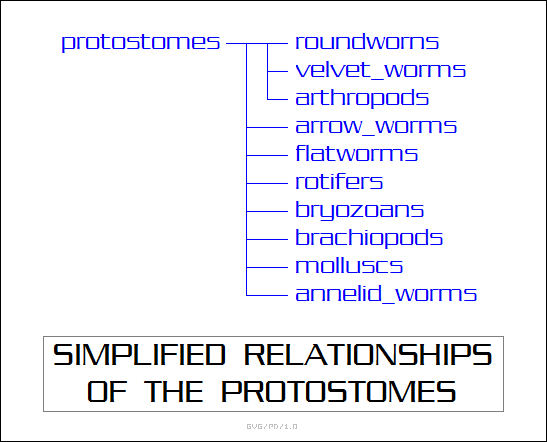
Modern protostomes include a wide grab-bag of organisms, including:
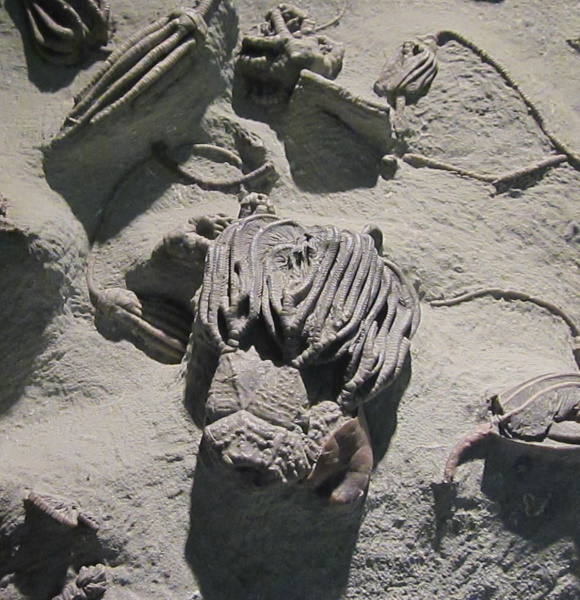
As far as the deuterostomes go, there are two primary branches:
There is an obscure third parallel group of deuterostomes in the form of the marine "acorn worms"; as with the obscure groups of deuterostomes, they are only mentioned here to ignore them.
Of course, to the extent that their histories are known, not all these groups arose in the Precambrian, and certainly many of the modern forms did not arise until much later. However, the ancestral basis of all these modern organisms clearly emerged during that era.
BACK_TO_TOP* The Cambrian period saw a grand flowering of multicellular organisms that has been called the "Cambrian explosion". Among the protostomes, the clamlike brachiopods became established, as did mollusks in the forms of snails and clams. The protostomes also provided the most distinctive citizens of the Cambrian, the "trilobites", which were early representatives of the arthropods.
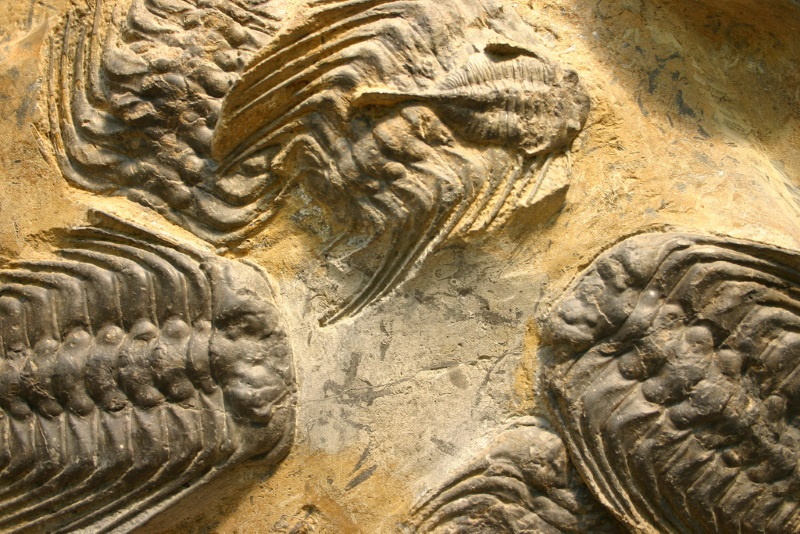
The arthropods are represented in modern times by:
There are also a few obscure outlier groups of organisms that are closely related to, but distinct from, insects; insects and these organisms are known as "hexapods", indicating their six-legged nature, but that distinction is ignored here for simplicity. There was dispute for a long time on the relationship between the crustaceans and insects, but they are now recognized as sibling clades, together being known as the "pancrustacea". The trilobites, incidentally, although often compared to modern woodlice or horseshoe crabs, were not members of any of these four groups, being a group of their own.
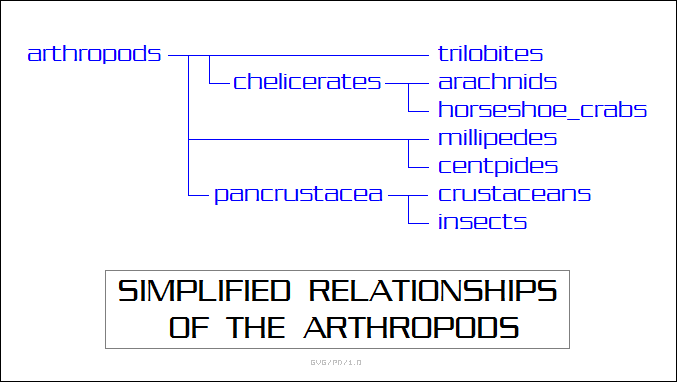
The arthropods are generally believed to have descended from "primitive" worms, one of the neat pieces of evidence being the modern velvet worms of the tropics. These creatures appear sluglike at a casual glance, but detailed inspection shows they have many arthropod features, such as compound eyes and similar jaw structures, and are the only creatures besides the arthropods that have to molt to grow.
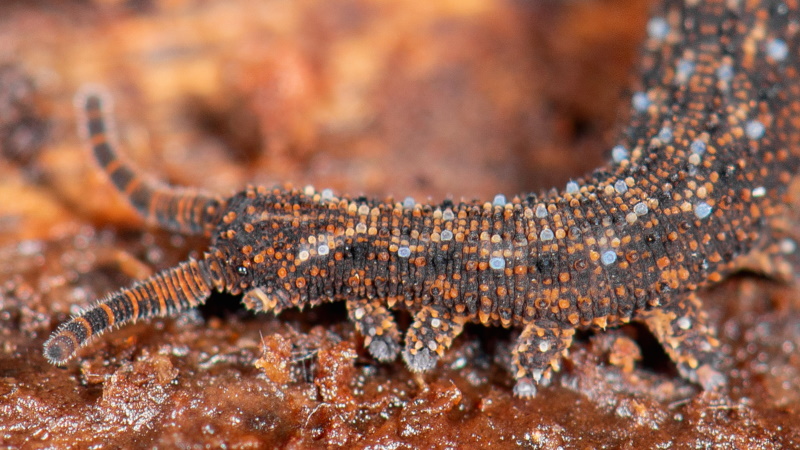
The brachiopods and trilobites are noticeable in the Cambrian fossil record because they had hard body parts. However, soft-bodied animals also left their traces in Cambrian stone, most significantly in the "Burgess shale" deposits of the Canadian Rockies. The 120 or so creatures found in the Burgess shale range from various kinds of sea worms to utterly bizarre creatures -- one animal that looked like a caterpillar with spines is even called Hallucigenia, the paleontologist who found it being perfectly amazed at the thing.
As far as deuterostomes went, the soft-bodied creatures also included chordate animals ancestral to fish, represented by the "living fossil" -- with the usual qualifications attached to that term -- known as a "lancelet" or "amphioxus", one of the most "primitive" of the animals with a spinal cord, the "chordates". A modern lancelet actually looks a bit like a minnow, with a streamlined shape and a swimming tailfin, but though it has a spinal nerve cord, it has nothing that faintly resembles bones, much less jaws, and has the most rudimentary excuses for eyes and a brain. However, the ancestral proto-lancelets of the Cambrian were clearly a pattern that went on to greater elaboration in time.
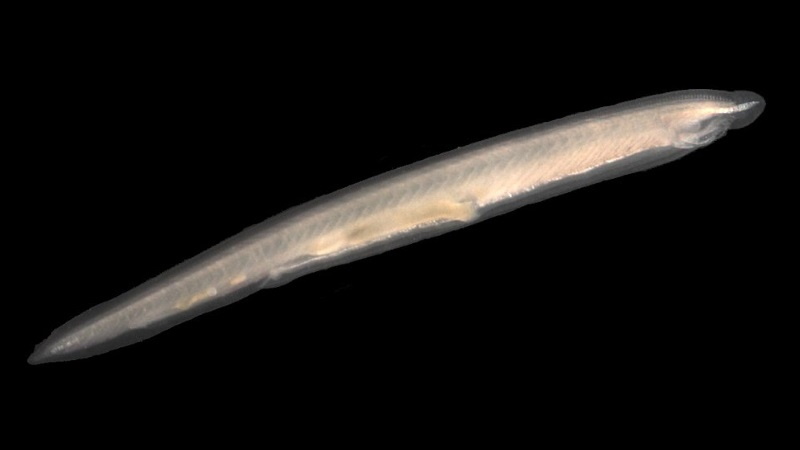
* The Cambrian did see a great expansion in the diversity of life, but was it really an "explosion"? The "explosion" may have been something of an artifact. As discussed previously, the older the fossils, the rarer they are, in large part because the dynamic nature of the Earth's crust tends to destroy geological structures over time.
Also as discussed previously, soft-bodied animals don't fossilize easily, and it wasn't until shelled animals emerged that they left more of a trace in the fossil record. Shelled animals weren't really a Cambrian innovation either, since fossil digs show that "small shelly fossils" -- the "SSFs" or "small shellies" -- with sizes of up to about a centimeter were common in late Precambrian days.
On top of that, although some paleontologists have claimed the Cambrian was marked by large numbers of entirely unique phyla -- Stephen Jay Gould pushed this idea in his book WONDERFUL LIFE -- critics accuse them of exaggerating, pointing out that supposedly unique organisms of the era can actually be generally accommodated in known phyla. The Hallucigenia fossil turned out to be much less bizarre once more fossils of the creature were found and showed that the original interpretation of the organism rendered it upside-down, presenting spines on its back as a row of legs. It was quirky, but not that quirky, and the general belief these days is that it was a relative of the velvet worm.
Another relevant observation is that studies of gene trees of organisms traced back through the Cambrian show that a large proportion of the gene families found in these organisms seems to have been established in the billions of years before the Cambrian. In other words, if there was a relatively rapid change in form during the Cambrian, it was due to variations in gene families that had long been established, not a rapid emergence of new gene families.
Finally, even if there actually was a fair burst of "evolutionary enthusiasm" at the beginning of the Cambrian, the species we have discovered clearly emerged over tens of millions of years, which is plenty of time for evolution selection to generate great changes. Even if we took the most drastic evolutionary change from one species to another found over the interval and assumed it took place over ten million years, that would mean an average change in form of only a hundredth of a percent every thousand years -- a change that would be effectively unnoticeable on the scale of human history. Ten million years is a very long time, and there's no logic for declaring it too short a time for great changes.
Creationists quick to exploit to proclaim the Cambrian explosion reveals some fundamental failing of MET. There's nothing to get so excited about; if there is a "problem" in the matter, it's of not having enough hard data to be able to sort the matter out just yet. There's been a push to call it the "Cambrian expansion" instead, not only getting rid of the dramatics -- but more importantly placing matters into their proper perspective.
BACK_TO_TOP* The Ordovician period, beginning 505 million years ago, brought a number of new actors onto the stage. The Ordovician saw the emergence of the deuterostome echinoderms lower on the food chain, with the crinoids being a characteristic fossil of the era.
The protostomes were not overshadowed, however, since the real "lords of the sea" at the time were the "nautiloids" -- a set of members of the family of "cephalopod" mollusks, which include the squid and the octopus. The nautiloids survive today as the chambered nautilus, which has a spiral shell plugged at the mouth by a set of tentacles, with an eye on each side of the base of the bundle.
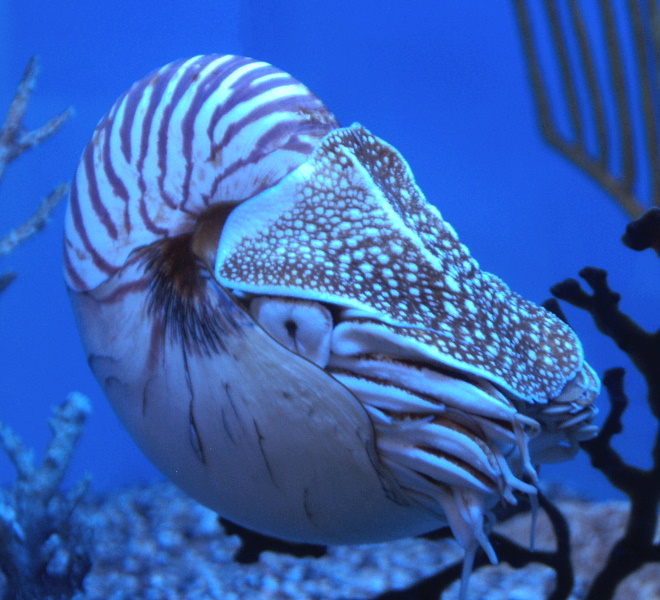
Back in the Ordovician, some of them had straight shells, which likely made it easier for them to swim -- cephalopods typically swim by jetting water through a siphon, with the result that they move "backwards", with the tentacles at the rear. One straight-shelled species had a shell 3.5 meters long -- making them the biggest known animals of their era. Nautiloids were actually known from the Cambrian, but they were smaller and by the evidence not all that common, coming into their own in the Ordovician.

One of the most interesting events in the Ordovician was the emergence from amphioxus-like primal vertebrates of the first real fishes. Actually, it might be more accurate to call them "more or less real" fishes, because they didn't look much like any fish we might find today: they didn't have jaws and had heads covered with bony plates. Such "ostracoderms" were likely slow-moving bottom feeders, cruising along at a slow pace -- with all that bone, they couldn't manage much speed -- vacuuming up food whole for digestion. They had a tail, but no auxiliary control fins. One "agnathan" (jawless fish) survives today -- the parasitic, rasp-mouthed lamprey, though it has little resemblance to the early ostracoderms. Incidentally, the jawless eel-like scavenging hagfishes were long thought to be agnathans, but genetic analysis eventually showed they were descendants of fish that had lost their jaws.
As with the Cambrian, there was no life on land during the Ordovician. Processes of continental drift continued, possibly affecting the climate. Whatever the causes, the climate at the end of the Ordovician did change drastically, with a severe drop in sea levels and another ice age -- though not as severe as the Snowball Earth episodes. The number of marine species that died out in that time is estimated at about 60%. This was the first "mass extinction" in the history of multicellular life; it wouldn't be the last. Darwin had rejected the idea of catastrophic creationism, adopting instead as part of his worldview Lyell's notion of geological gradualism, but as it turned out, Cuvier's catastrophism was not entirely wrong.
BACK_TO_TOP* The Silurian period, beginning 435 million years ago, picked up where the mass extinction of the late Ordovician left off. Although the trilobites had suffered badly, they survived, to be joined by another class of arthropods, the "eurypterids" or "sea scorpions". They weren't scorpions as we know them, being more closely related to horseshoe crabs, but they did have scorpionlike whip tails -- along with big lobsterlike claws. The sea scorpions are now seen as the "signature" creatures of the Silurian, attracting attention because of their large size, up to over two meters.
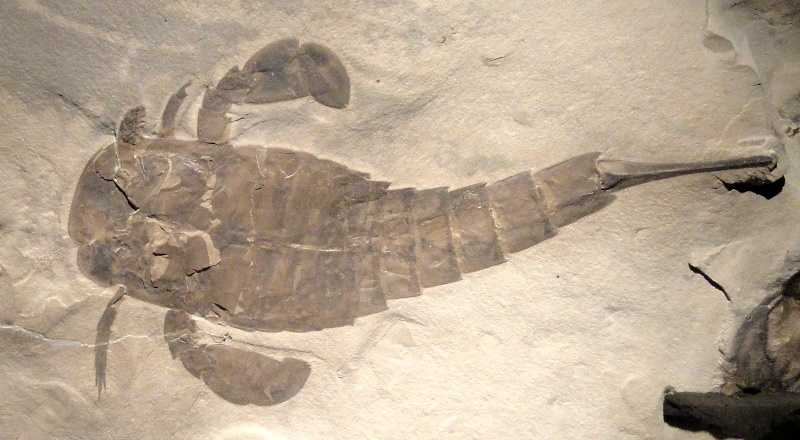
They were the biggest arthropods ever. It's not hard to see why arthropods never got any larger, since the requirement that they molt their external exoskeletons is troublesome, and it gets more troublesome as their size increases. When competitors became widespread later, the penalties of molting would cut arthropods back down to size; the biggest we have today are king crabs. In any case, the sea scorpions shared their environment with aquatic true scorpions -- a surprising notion, since these days all scorpions are land animals.
At the beginning of the Silurian, the fish were along the same lines as they had been, with armored heads, no jaws, no skeletons, and simple tails for swimming -- though these "heterostracan" fishes were more dartlike and hydrodynamically efficient. The fossil record seems to indicate they were much more widespread. Late in the Silurian, "osteostracans" arose that featured a significant innovation of left and right "pectoral" control fins, providing greater agility in swimming. The late Silurian also saw the introduction of the first "gnathostomes" or jawed fishes, a significant development: they would ultimately push the agnathans into their modern niche existence. The structure of the gnathosome jaw strongly suggests that it was derived from the gill structures of earlier fishes.
Later in the Silurian, scorpions and some other arthropods ventured out onto land. Plants began to make an appearance out of the sea as well, though the forms were "primitive", lacking leaves, some along the lines of the cactus but lacking spines -- there weren't many animals around that could graze on land plants in those days, what function would spines serve? They did feature, however, a semi-rigid structure that allowed them to stand upright; a waxy surface "cuticle" to provide protection, penetrated by pores called "stomata" to vent in carbon dioxide; as well as "vascular" system to transport fluids and nutrients -- all distinct changes from the limpid sea plants that came before them.
* The Devonian period, beginning 410 million years ago, saw the introduction of fish that we would unambiguously perceive as fish. The earliest jawed fishes retained the overall structure of their ancestors -- a body without a skeleton and an armored head. There were a number of variations, with the most impressive being the "placoderms", which could run to up to 6 meters (20 feet) in length and had jawbones with bladed edges and fangs. Their fossils are often found during excavations of shale deposits in the city parks of Cleveland, Ohio.
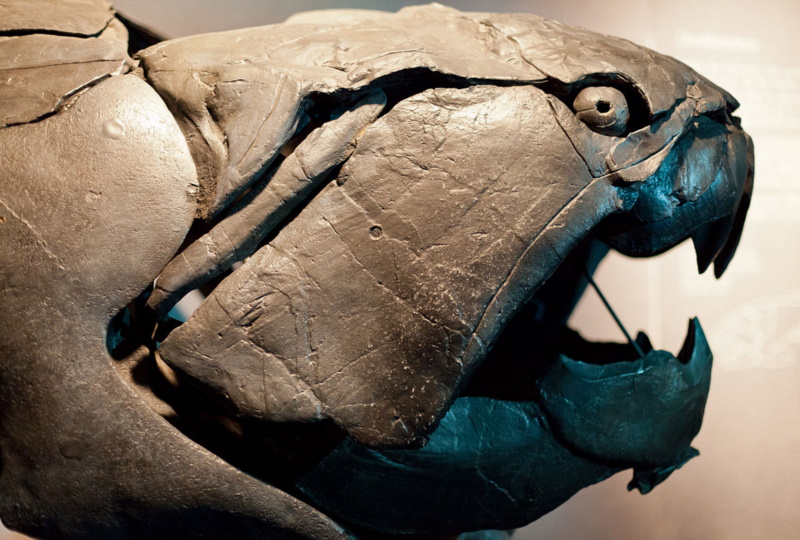
The early fish configuration was not the way of the future. Cartilaginous fishes -- with a skeletal structure of girdles of soft cartilage instead of hard bone -- made their appearance in the form of rays and sharks. Although the cartilaginous fish are of a very ancient lineage, they continue to thrive today in a wide range of forms:
Early sharks hadn't obtained the sleek hydrodynamic efficiency of some modern sharks, but the basic shark configuration was recognizable. In any case, the cartilaginous fish led in turn to the "osteichthyes" or true bony fish, which had their roots in that period. There were two branches, including the "sarcopterygians" or "lobe-finned" fishes, and the "actinopterygians" or "ray-finned fishes".
The lobe-fin fishes feature four strong, muscular fins arranged roughly where the legs of a four-legged land creature would be. Lobe-fin fishes are known from the Silurian; they tend to be unusual today, the most famous example being the "coelacanth" -- another "living fossil", in fact thought extinct for hundreds of millions of years until a number were caught from deep waters in the Indian Ocean during the 20th century. Their fin structure would open up an evolutionary door.
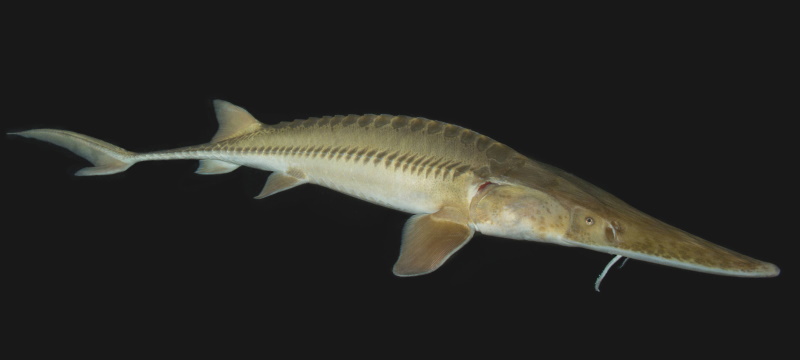
The ray-finned fishes are what we consider to be ordinary "fish" these days, featuring very thin fins, made of a fan of bones covered by skin; they tend to be hydrodynamically efficient and maneuverable. They are really only known from the Jurassic, and they didn't prosper until the Cenozoic, the end of the age of great reptiles. They are now the dominant fish in the oceans. In modern times, there are two broad groupings of the ray-fins:
Incidentally, the relationship between bony fish and the cartilaginous fish is not all that close. A trout is more closely related to a human than it is to a shark -- which is less surprising when it's considered that both a trout and a human have skeletons while a shark, strictly speaking, doesn't. The term "fish" is a grade, since we're on the same big branch of the tree of life as a trout, but the shark isn't.
* Trilobites were still around in the Devonian, but their wild diversity of forms suggest that they were having a much harder time of it. Some could roll up into an armored ball, sort of like pill bugs; others had extensive networks of spines; still others had eyestalks, which they could have used as "periscopes" to allow them to see what was going on while hiding under the seafloor.

The invasion of land accelerated during the Devonian. Ferns and horsetails populated the dry earth, to be joined by "progymnosperms" -- the first real trees, with wooden trunks and fan-shaped leaves. Seeds finally emerged, a more reliable means of reproduction than spores or branching off runners. Land vegetation was no longer sparse and puny, and some paleontologists like to speak of a "Devonian expansion" of land plant forms, along the lines of the Cambrian expansion of marine invertebrates.
Centipedes, millipedes, and cockroach-like flightless insects wandered through the ancient forests. Late in Devonian, the first land vertebrates -- amphibians known as "tetrapods" -- were crawling up on the land. They weren't so much different from modern salamanders, equipped with some features of fish. They also didn't lay hard-shell eggs and had to go back to the water to spawn, with the eggs emerging as larva, in exactly the same way a modern frog spawns its eggs in water that then emerge into tadpoles.
Incidentally, the term "amphibian" is misleading, since there are a lot of creatures that are amphibious, but not lumped together with salamanders and frogs. As a taxonomic distinction, it is a grade, merely convenient, since it excludes all the other animals, such as us, that descended from the early tetrapods. The term "tetrapod" is in itself a bit confusing, since all it means is "four-legged" -- in cladistic terms, a cow is properly a tetrapod, and in fact taxonomists refer to a snake as a tetrapod since it had four-legged ancestors. In this context, the term is used solely to designate "primordial tetrapods". In any case, the tetrapods were clearly an outgrowth of the lobe-finned fishes; intriguingly, the operational sequence of the four fins of the coelacanth is in the same pattern as the leg motion of modern crawling amphibians.
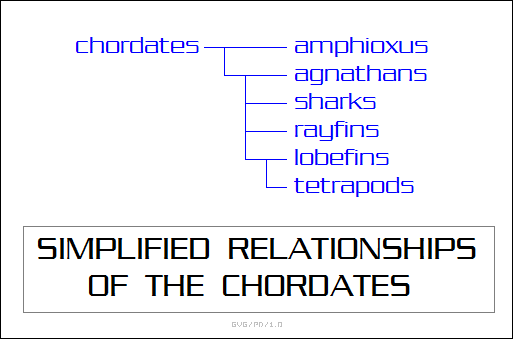
Obviously some lobe-finned fish got lucky in the evolutionary lottery and acquired the trick of being able to crawl out onto land for short periods -- a scheme hinted at by the modern "mudskipper" of Southeast Asia, which is a ray-finned fish with frog eyes that can crawl around on the land for a surprising length of time. Another modern hint is the "lungfish", which can't go onto land, but which can surface and breathe in air, a useful trick for a creature that lives in brackish, oxygen-poor water.
Where the lungfish of the past got the lungs is another interesting question. The cartilaginous fishes don't have any means of maintaining neutral buoyancy and tend to sink; this isn't a real problem with rays and mudsharks, which live on the bottom anyway, but other sharks have to keep moving at all times to stay afloat using underwater "lift". The bony fishes improved on this scheme by obtaining a "swim bladder" that could be filled with air or deflated to maintain constant buoyancy. It was once thought that the swim bladder later led to lungs, but the evidence is accumulating that it was the other way around: fish acquired lungs, likely as an outgrowth of swallowing gulps of air from the surface of brackish waters, and the fish lung led to the swim bladder.
The fossil record of tetrapods was frustratingly skimpy for decades, not represented by much more than a single species known as Icthyostega, but since the 1990s new fossils have been found at a surprising rate, and now it's one of the major stories of evolutionary paleontology. Most significantly, a species named Tiktaalik discovered in the barrens of northern Canada in 2004 that is so fishlike it has been described as a "fishapod". The origin of the tetrapods is now so elegantly well-established as to be another showcase for evolutionary science.
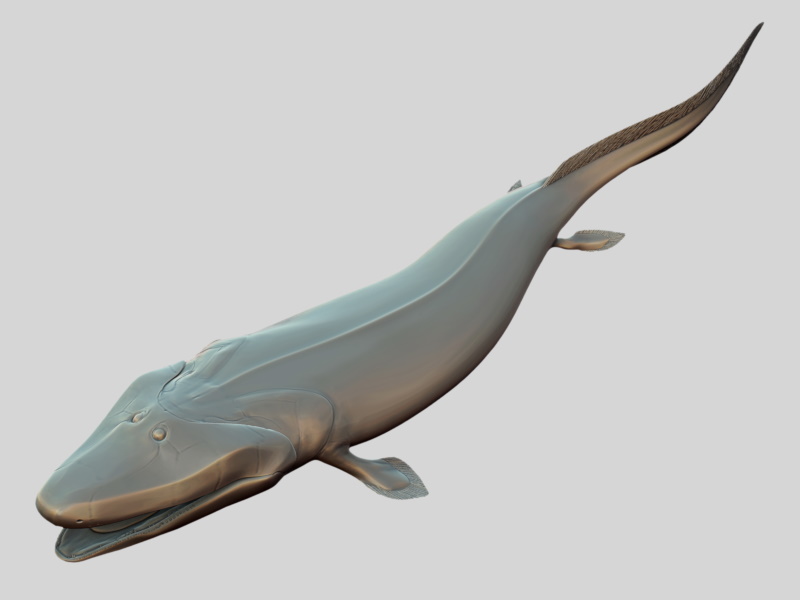
The general assumption for the origins of the tetrapods had been that legs came in handy for moving across land when ponds dried up, but the more recent finds have shown the early tetrapods couldn't possibly walk on land -- the legs just weren't strong enough. There are some modern fish that have strong fins that they use to creep over the seafloor, which allows them to move more stealthily in cluttered undersea vegetation. The early legs might also have been used for scrambling over obstacles in shallows and swamps, and for pushing the head above water to get gulps of air in brackish water. Early tetrapod skeletons have feet with eight digits, in contradiction of the common configuration of five digits for land creatures; it appears that the extra digits were lost as the legs became stronger and more adequate for walking over the ground.
The initial tetrapod configuration has a problem: it doesn't permit an animal to run and breathe at the same time. Modern amphibians, lizards, and crocodiles suffer from this constraint, and so the predators among them are "ambush" predators, lurking and waiting for prey to come by and either snapping it up or grabbing in an abrupt dash. The general resolution to the problem is an erect gait, either standing with four legs beneath the body instead of out to the sides, or standing on two legs.
BACK_TO_TOP* The Carboniferious period, beginning 360 million years ago, involved a world carpeted with greenery, plants including mosses and ferns; there were even forests. They weren't much like forests we know today, being dominated by tree ferns, plus a wide range of other trees that haven't survived, at least in the form of trees, to the present. Some forms of "lycopod" trees, related to modern "club mosses", appear particularly bizarre by modern standards. They have been referred to as "green scaly telephone poles"; they grew straight up without branches to terminate in one or more "pompoms" of long, whiplike leaves. They had sprawling root systems and very thick, scaly bark to support their height, since they weren't woody plants, being pulpy inside.
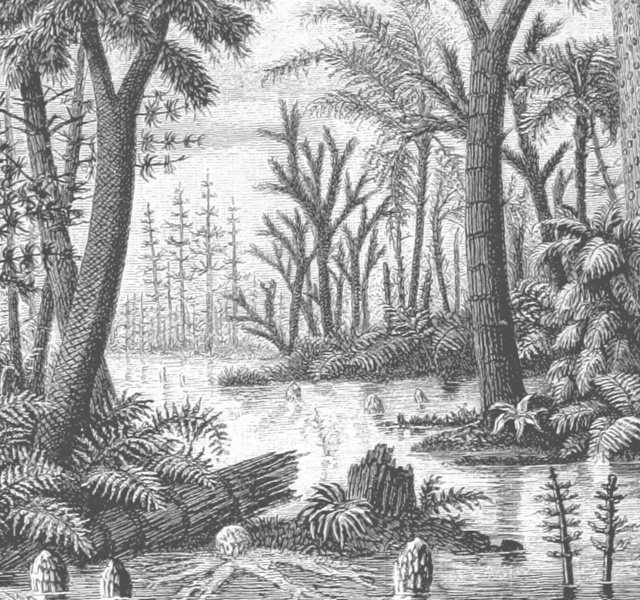
A forest of such lycopods has been compared to a grove of giant pipe cleaners. Other forms featured sets of branches that grew up into a canopy. They reproduced using cones, but the cones contained spores, not seeds. Other trees of the era were not so bizarre -- the "pteridosperms" looked like tree ferns, but they reproduced using seeds, not spores.
The amphibians thrived in the era. The Carboniferous also saw the introduction of flying insects. The best-known survivor from those days is the dragonfly, with its "primitive" wings -- it can't fold them when at rest, a trick that its otherwise similar relative the damselfly later acquired. However, modern dragonflies are dwarfs compared to the biggest Carboniferous species, which had wingspans of up to 60 centimeters. There are even more startling remains from the late Carboniferous of something that looked like a millipede but was 1.8 meters long, and scorpions bigger than 60 centimeters. Why did bugs get so big? More oxygen in the atmosphere? Concentrations of atmospheric oxygen reached a peak of 35%, approaching twice that of today. Warm climate? Lack of competition? Nobody really knows.
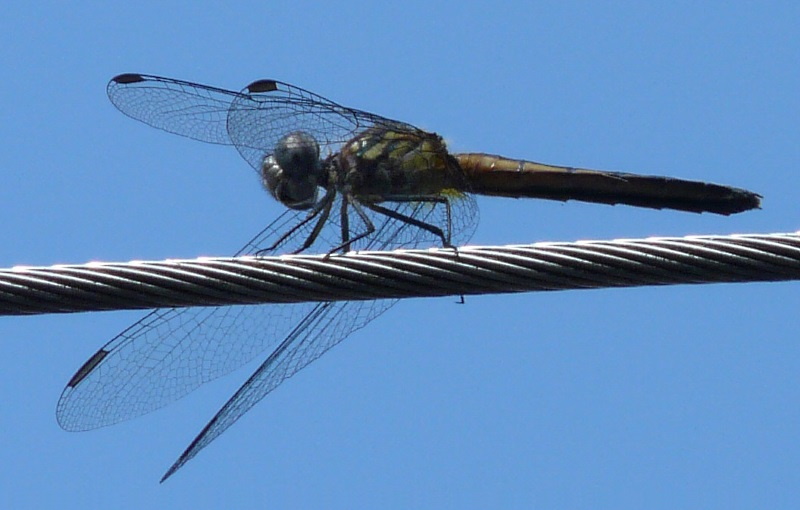
Although some types of fossils are hard to come by, we are economically dependent on fossils from the Carboniferous era. The lush vegetation of the era accumulated in great beds; the beds would be buried and turn into coal and oil. Some big lumps of coal can be carefully broken open to reveal well-preserved plant fossils. We tank up our cars on the remains of Carboniferous forests -- at least for the time being.
* The Permian period, beginning 290 million years ago, moved the scene of most interesting developments to land. Amphibians continued to thrive, including species that looked like snakes, or looked like crocodiles, or had big crescent-shaped heads. New plants appeared, including:
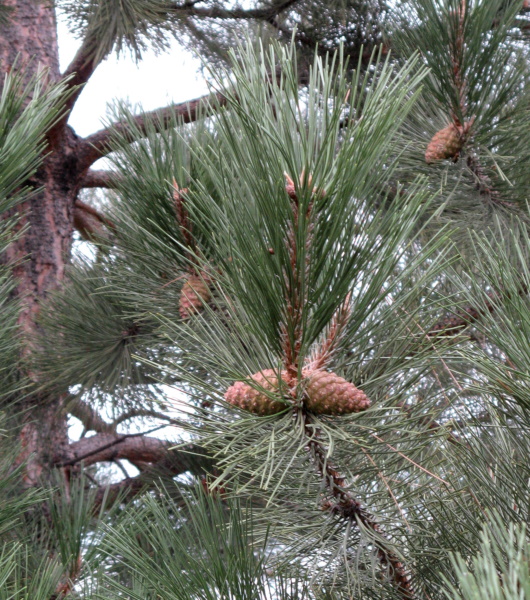
Successors to the amphibians were beginning to come into their own. The new generation of animals, the "amniotes", reproduced using the "amniote egg", a neatly packaged environment in a hard shell for their offspring to grow through their larval stage and then hatch as little replicas of adults. No more going back to the water to spawn tadpoles. Some unusual species of modern frogs suggest intermediates to this configuration, with fully-formed young emerging from their eggs, though the eggs do not have a hard shell.
The amniote successors include three main lines, distinguished by distinctly different skull structures with differing numbers of holes behind the eye socket:
Although anapsids and diapsids were both well represented in the Permian, the synapsids were the "signature" creatures of the time. The synapsids are divided into two main groups: the "pelycosaurs", including the well-known "finbacks" or "sailbacks" with "sails" on their backs, sometimes incorrectly referred to as "sailback dinosaurs"; and the "therapsids", which are generally stereotyped as stumpy, squat beasts, though there was more diversity among them than that.
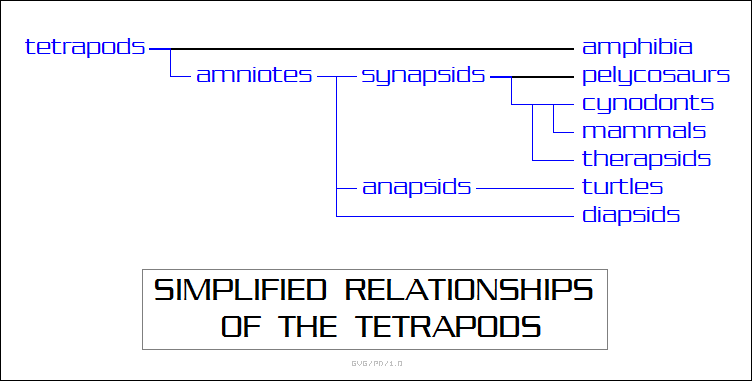
There were herbivorous and carnivorous forms among the pelycosaurs; in fact, the pelycosaurs are a paraphyletic grade, yet another diverse group of organisms that don't make up a neat family. Incidentally, nobody has any clear idea what the sail of the sailback pelycosaurs was for. The most popular idea is that it was for thermal regulation. It has been suggested that it might have been for sexual display, but the sail is found in clearly different species and sex-derived features tend to be freakish, rarely specifically shared between different species.
There were also herbivorous and carnivorous forms among the therapsids. They were the more or less direct ancestors of the mammals, with members that looked distinctly doglike, being what popular biologist Richard Dawkins once called "almost perfect intermediates".
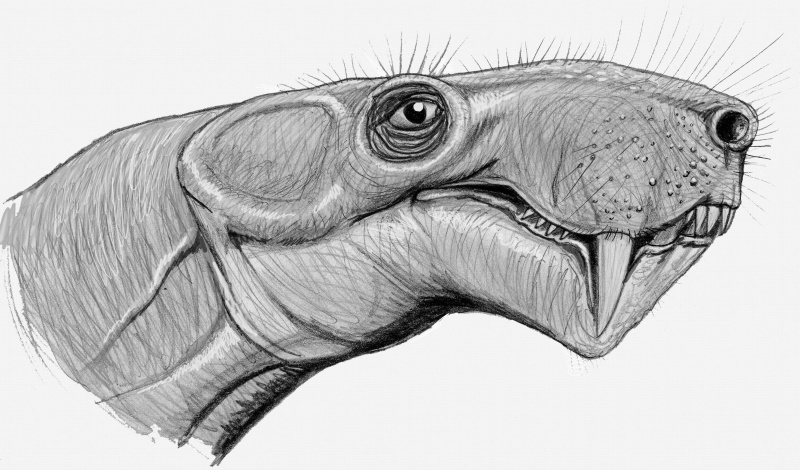
* As noted, the term "mammal-like reptiles" is now argued as out-of-date. This is because, in light of cladistics and improved data, the term "reptile" has become somewhat dodgy. The problem is that, getting ahead of the discussion a bit, the synapsids led to mammals, and the diapsids led to birds. That means that from a cladistic point of view, the term "reptile" would necessarily also include mammals and birds. Cladistically, there's not much alternative to dismissing the reptiles as a true clade, simply reserving the term as a grade, "Reptilia*" -- or more informally "reptilians", a term more descriptive of a certain general form than a classification. Why not? We call sharks and salmon "fish" but as noted, they're not really members of a unified group.
As far as technical definitions go, we now specify the three branches of creatures once known as reptiles as synapsids, anapsids, and diapsids. No more "mammal-like reptiles" -- they're "proto-mammals", or somewhat redundantly "synapsid proto-mammals". However, old habits die hard and the term lingers, partly from inertia and partly because it can seem perverse not to call these creatures "reptiles". Anybody who takes a glance at a picture of a sailback predator, like the well-known Dimetrodon, sees it as a gruesome scaly reptilian monster from hell that makes a crocodile seem charming in comparison.
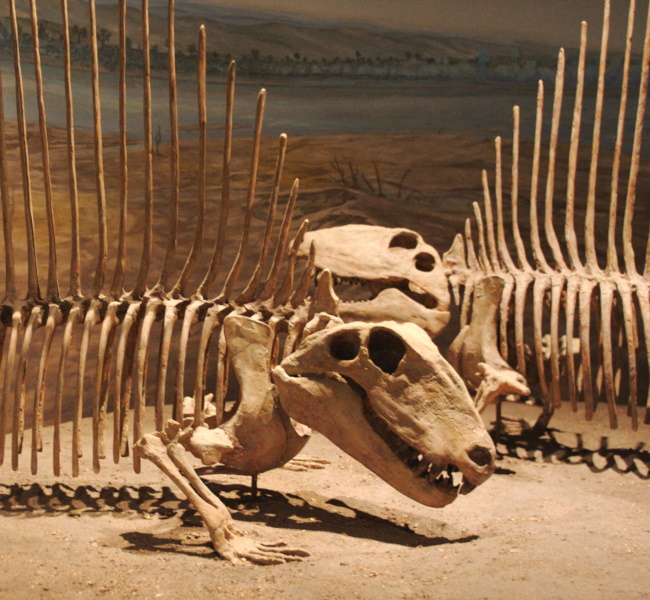
* The Permian period was the last of the Paleozoic era, and its end was not a subtle event, the "Great Dying" being the biggest mass extinction in the history of life. The trilobites died out completely, losses of many families of marine invertebrates exceeded 90%. Others did not fare quite so badly, but all suffered.
Nobody really knows what happened. There is evidence of major eruptions, and the extinction also broadly coincided with the emergence, through collisions of drifting continents, of the supercontinent "Pangaea" -- which would be the last of the supercontinents, and the direct ancestor of all the modern continents. The creation of Pangaea, and the complementary "superocean" named "Panthallassa", may well have shifted the climate.
Some suggest that the seas all went brackish in rising heat, with sulfur-metabolizing microorganisms taking over and filling up the atmosphere with toxic hydrogen sulfide gas. Oxygen levels fell from their peak to roughly modern levels or somewhat less, which may have helped stress organisms. There is also evidence of a giant meteor impact -- maybe it was just the entire Earth having a nasty spell of bad luck more or less at once. Whatever the causes, the world in the new Mesozoic era would look very different.
BACK_TO_TOP